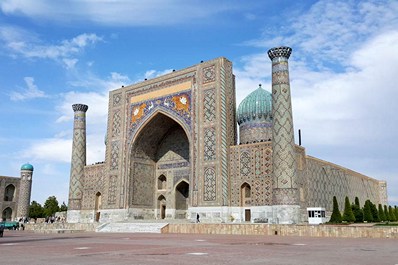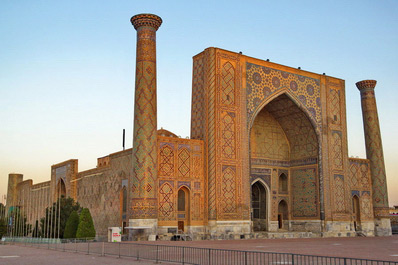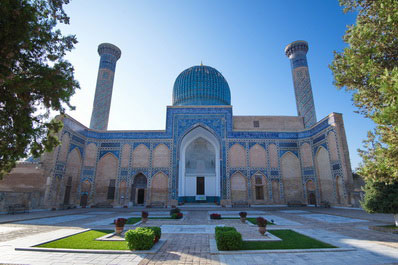History of Samarkand
There are cities which centuries-old history embodies the history of whole nation and countries, reflecting the way passed by many generations. Samarkand is one of the most ancient cities in the world. As other first centers of human civilization - Babylon and Memphis, Athens and Rome, Alexandria and Byzantium - Samarkand was intended to go through many events and shakes.
History of Samarkand goes back in remote days. Archeological finds and chronicle records of eyewitnesses and ancient historians allowed to establish with full reliability that a man lived on the territory of modern city many centuries before the Common Era.
Advantageous geographical location, rather favorable climate, abundance of natural springs with fine water, nearness of mountains with large wild fowl, flowing Zaravshan river - all these factors always provided favorable conditions for human settlings in that area, where strong walls, castles, majestic buildings and temples of Samarkand raised some centuries before the Commone Era.
In historical events of ancient time the earliest mention about Samarkand (also known as Marakand) dates to 329th year B.C., in descriptions of eyewitnesses and participants of conquering army of Alexandr the Great. By that time Samarkand was a big city with crowded population, developed crafts, trade, and culture. It had unassailable citadel and outside defensive wall with length of 10,5 kilometers.
According to new archeological excavations scientists concluded that Samarkand was founded much earlier than Greek-Macedonian conquest and already during the epoch of the Akhemenids State (6-4th centuries BC) it was quite developed city. Hence the “age” of Samarkand is over 2500 years, starting from the origin on the forest hill of Afrosiab, though it is far older.
Over the history the city saw half-savage tribes of Sacs and Massagets, iron flanks of Greek-Macedonin army, hordes of cruel Kara-Kidani. The city withstood invasion of the Arabs, who brought with them a new religion - Islam. Bloody hordes of Ghengis-Khan attacked peaceful houses with fire and sword. Samarkand became the capital of Great Empire of Tamerlane, ranged from Ind River to Bosfor.
After Timur’s death all his empire came to the power of his children and grandchildren. Samarkand and surroundings devolved to Ulugbek, Timur’s grandson. Ulugbek ruled Samarkand during 40 years. For the whole history Uligbek was the most peace-loving ruler. He almost did not participate in aggressive campaigns over ruling his state. He visited other countries many times but only to study traditions, culture, and customs of those countries. He was great scientist, astronomer, and mathematician; therefore he brought many scientists from different countries for science development in his county.
14-15th centuries is the period of the Golden Age of the city. City construction is at its zenith: the city is surrounded by strong fortified wall, new streets, paved of stone, are laid through the city, blue domes of magnificent ensembles tower above the city. Most of these objects survived our days and are the main symbols of the city.
Today Samarkand like most cities of Central Asia is divided into two parts: old and new city. New part is an administrative part of the city, including industrial and cultural centers, high educational institutions. Old part of the city includes historical monuments, shops, workshops, old private houses. Generally, an excursion is held in the old part of the city. Samarkand numbers 500 thousands people. This is multinational city, more that 100 nations live in Samarkand. Samarkand takes second place in Uzbekistan by number of population and territory.




